All things are created twice. First in the mind, and then physically, in the world.
Stephen Covey, The Seven Habits of Highly Effective People
Before ideas make their way into the world, for many writers, there is a vital intermediate step: Creation by notebook. The Bible backs me up on this: “In the beginning was the word.” Words need to be organized and stored as carefully as any other precious resource, if they are to unleash their world-changing power.
After years of exploring the world of planners, journals and organizational how-to books, I have developed an idiosyncratic three-notebook system that keeps me on track as a writer, while role-juggling as a professional and mum. I share it here in the hope that elements may help you progress treasured projects of your own.
Three is a Magic Number . . .
I operate best with:
- An annual planner to organize my life at large.
- A writing journal, where I lay out my writing plan for the year, broken down into quarters and months; and
- A daily notebook, as an all purpose whiteboard, serving alternately as office space, jungle gym and open landscape for the mind and heart.
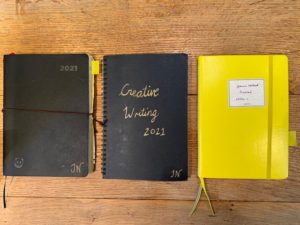
I stash them in a traveler’s notebook, which is a large leather case rigged with elastic thread, allowing individual notebooks to be removed and replaced.
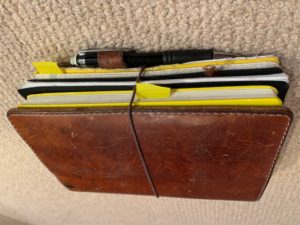
Planner
In Getting Things Done, productivity consultant, David Allen, wrote that capturing and organizing commitments and reminders frees the mind to imagine, plan and execute. While my planner does not focus on my writing, it anchors me, so as to make writing possible. I’ve found that a paper planner allows me to visualise the road ahead, though I also use an electronic backup. A paper planner also offers space for scribbles and doodles, such as the daily drawings I add to the squares of my monthly calendar, to remind myself of something special about each day.
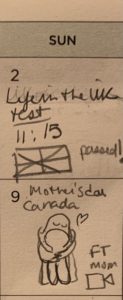
Writing Journal
My spiral A5 writing journal contains the evolving blueprint for my writing plan for the year. Checking in with it regularly helps me keep my writing goals feeling vivid and pressing.
It includes:
- My mission statement as a writer and blogger
- My inspiration bank of ideas for stories and blog posts
- A repository of similes and metaphors. I jot them out as I think of them, and leave them to simmer until Right Story comes along
- My long-term writing goals
- My goals for the year
- Monthly spreads, with a calendar, key goals, books to read, a habit tracker, and milestones
- Quarterly trackers summarising:
- Goals
- Achievements
- Setbacks
- Contacts made
- Key learning points
- Favourite books
- A listing of competitions and courses
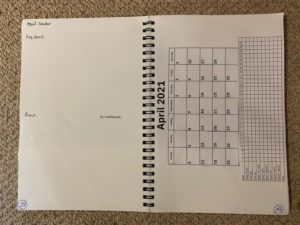
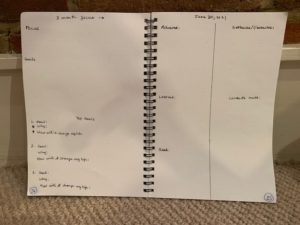
The inspiration bank has been particularly fruitful. I believe that writer’s block does not spring from a deficit ideas — we humans are idea machines! — but rather, from a failure to recognize, capture and develop them.
Daily Notebook
My notebook contains a hodge podge of notes, sketches and mind maps — work meetings, vacation plans and story ideas — all, carefully indexed. (Numbered pages and an index are key.)
Particularly useful for my writing are:
- Landing pages for each writing project, to log ideas on the go.
- A 12-frame picture book spread, for working out the pacing of my picture book manuscripts.
- Notes and mind maps of books and lectures.
- Doggerel for friends and family. I often jot down a poem in the morning and play with it in odd moments before sending it off.
- A back page with quotes I want to revisit — Everything from Viktor Frankl’s life lessons to my daughter’s quip, during a game of Apples to Apples that an “ex” is “an unqualified man of hopes and dreams.”
- Sketching pages. I often sketch for friends and family, and send them a digital pic, or tear out the page to post (yes really! using an envelope and stamp!!)
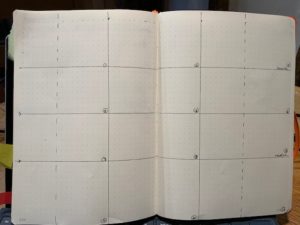
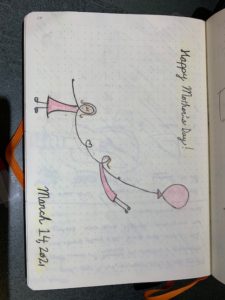
Influences
My key sources of inspiration for organizing and planning are:
- Getting Things Done, by David Allen
- The Seven Habits of Highly Effective People, by Stephen Covey, about structuring life in line with your principles
- 15 Surprising Things Productive People Do Differently, by Kevin Kruse. Sure enough, No. 6 is: “They use a notebook.”
- The Bullet Journal Method by Ryder Carrol
- Life Mastery Planner, by the Freedom Mastery company
I am also grateful to Fiona Barker for her YouTube video on the Picture Book Club channel about laying out a picture book across twelve spreads.
A Note on Stationery
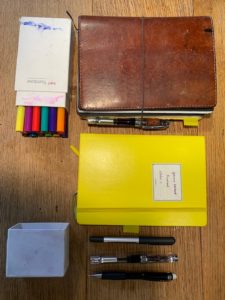 “If any man love the instruments of any craft, the gods have called him,” writes Pat Barker in The Silence of the Girls.
“If any man love the instruments of any craft, the gods have called him,” writes Pat Barker in The Silence of the Girls.
Sure enough, my obsessive relationship with stationery is a great spur to writing (if occasionally, a distraction from it.)
After years of expensive trial and error, my desert island survival pack includes:
Chic Sparrow Traveler’s Notebook: Traveler’s Notebooks are leather bound book covers, cleverly rigged with elastics to hold multiple notebooks. The Chic Sparrow brand is lovingly made with tactile, robust materials. I splurged for the pen loop and a spare pocket, where I tucked away a love letter from my husband, and an index card listing the books I want to read.
Smart Panda Planner: Functional and attractive, it provides full-year, monthly and weekly spreads in soothing muted colours, with a minimalistic design to maximise writing space.
Leuchtrum1917: With 251 numbered, dotted pages and an index, it’s as good as a notebook get. These hard-bound, carefully detailed beauties come in 27 different shades. I go through a notebook a month, and used to cringe at the price until I calculated that each side of A5 costs about 7 pence. If it takes me 10 minutes, on average, to fill a side, then at 42 pence an hour, it’s a forgivably economical indulgence.
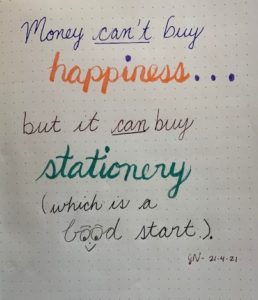 Twist-Erase 0.9 Pentel Automatic Pencil: Its rubber grip, solid build and sturdy lead support energetic sketching. Best of all, the retractable, replaceable eraser is fully three centimetres long — Ideal for people people like me, who figure out what we are trying to say through multiple cycles of writing and erasing.
Twist-Erase 0.9 Pentel Automatic Pencil: Its rubber grip, solid build and sturdy lead support energetic sketching. Best of all, the retractable, replaceable eraser is fully three centimetres long — Ideal for people people like me, who figure out what we are trying to say through multiple cycles of writing and erasing.
Wing Sung 3008A Piston Fountain Pens: Anne Frank’s touching elegy to her fountain pen in Diary of a Young Girl convinced me that true writers eschew ballpoints. So ink stains perennially mottled my fingers until I discovered this ridiculously cheap, smooth-writing, non-leaking brand. With a four-pack costing less than £20, you can treat yourself to different shade of ink for every mood.
Uni-ball Eye Micro Rollerball Pens: For the sheer joy of making a jet black line.
Tombow Brush Pens: I learned to letter from Boho Berry‘s YouTube channel.
Supersize post it notes: At 102 x 152 mm, they are the size of small index cards. Stick a stack at the back of your notebook, and uses for the will multiply.

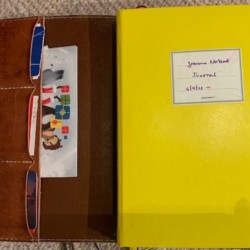

No comments yet.